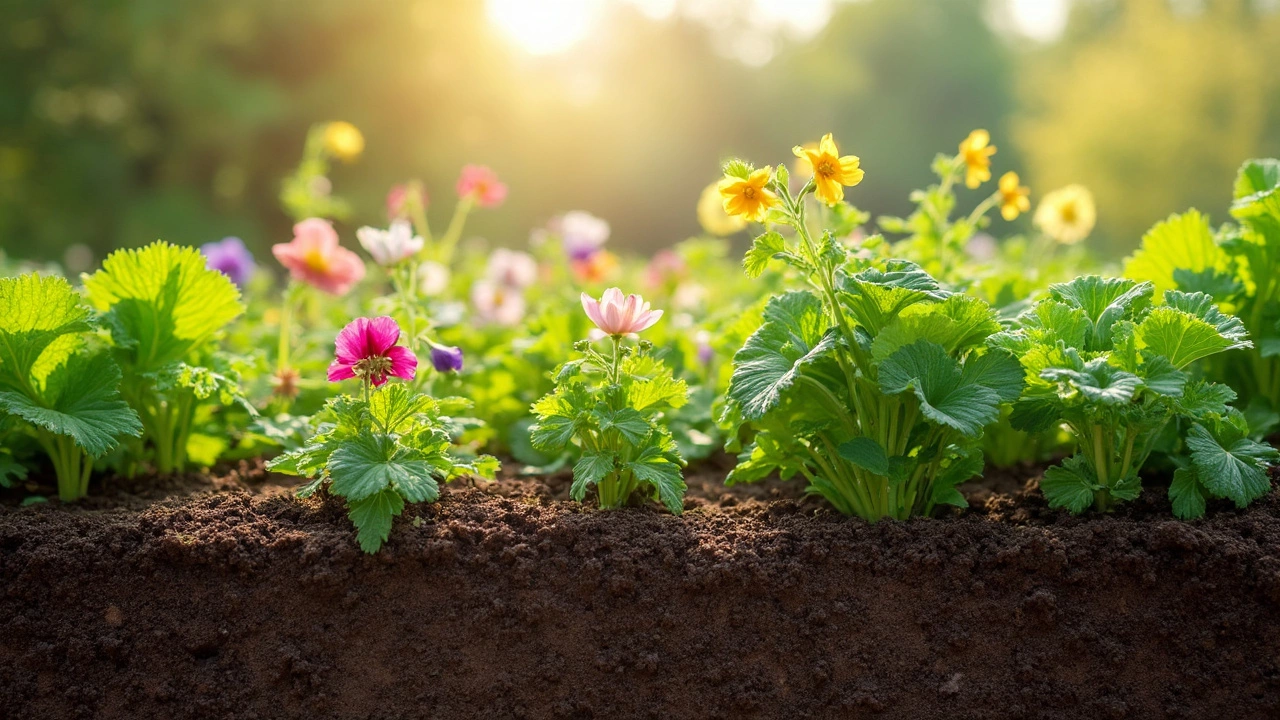Alright, so you've got your garden gloves on and you're amped up to get that patch of earth ready for planting. But hang on—have you ever stopped to ask yourself, 'How deep should I actually be digging into this soil?' Knowing the right depth to till can make a huge difference in how your plants grow and thrive.
First things first, let's chat about why tilling depth even matters. Tilling helps break up compacted soil, mixes organic materials, and loosens roots. But if you dig too deep (or not deep enough), you might mess with the soil's natural layers, affecting plant growth.
- Understanding Soil and Tilling
- Tilling Depth for Different Crops
- When Deep Tilling Works Best
- Benefits of Shallow Tilling
- Considering Soil Type and Conditions
- Practical Tips for Successful Tilling
Understanding Soil and Tilling
So, you've got your gardening gear ready, and the first step is to wrap your head around what tilling actually does for your garden. Tilling isn't just about plowing through dirt like a tractor on a farm—it's more about the strategic reworking of soil to make it more welcoming to seeds and roots.
Now, here's the scoop: soil is made up of several layers. The top layer, where plants thrive, is known as the topsoil, and it's loaded with all the good stuff like nutrients and organisms that boost plant health. When you till, you're basically mixing this layer to distribute these nutrients more evenly.
When you're reaching for that tiller, it's good to know that you're not just doing your plants a favor, but you're also helping out the soil structure. Tilling helps break up compaction, aerates the soil, and improves drainage. Ever notice how water pools on your lawn after a rain? That's poor drainage due to compacted soil, which tilling can fix.
- Garden tilling can help control weeds by chopping them up and burying their seeds deeper into the soil, making it harder for them to sprout.
- Be wary, though—tilling too much can disturb beneficial worms and microbes.
- As a general rule, most gardens benefit from being tilled to a depth of 6 to 10 inches to achieve a good mix of soil and added organic matter.
For those of you who love data, consider this little tidbit: a study found that gardens tilled to 8 inches showed a 15% better plant growth rate compared to those only tilled at 4 inches.
Remember, the goal of tilling is to get that balance right. Mix things up, but don't go overboard, so you keep all the soil's hidden helpers happy. Every turn of the soil gets you one step closer to that lush garden you dream about.
Tilling Depth for Different Crops
So, you're ready to start digging, but hold on—a one-size-fits-all approach doesn't quite work when it comes to garden tilling. Different plants have their own quirks and preferences, so understanding what each crop needs can really pay off in the long run.
For root veggies like carrots and potatoes, you're looking at a good, deep till. Shooting for around 12 inches helps these crops get the space they need to grow well. Anything less, and you might end up with some stunted or strangely shaped produce.
Meanwhile, surface dwellers like lettuce and spinach are a bit more laid-back. These guys can do just fine with a till that's about 4 to 6 inches deep. They're not digging down deep for nutrients, so keeping it shallow works just right.
If you're planning on planting tomatoes or peppers, aim for a solid medium depth, about 8 to 10 inches. This allows them to establish roots while still having access to nutrients.
Here's a quick look at different tilling depths for common crops:
| Crop | Tilling Depth (inches) |
|---|---|
| Carrots | 12 |
| Potatoes | 12 |
| Lettuce | 4-6 |
| Spinach | 4-6 |
| Tomatoes | 8-10 |
| Peppers | 8-10 |
Getting the depth right isn't just about the plants, though. Keep in mind the soil should be loose but not clumpy. You want a nice, crumbly texture that lets roots breathe while retaining moisture. So, next time you're out there with your tiller, think about what you're planting and adjust accordingly. Your plants will thank you with a much better yield.
When Deep Tilling Works Best
So, you're thinking about diving deep with your tilling? Great choice, but it's not always a 'one size fits all' scenario. Garden tilling at greater depths can be super effective, especially when you want to give plants with longer root systems—the ones that like to stretch their legs—a nice home.
Deep tilling, usually going down to 12 inches or more, is perfect for root veggies like carrots and parsnips. These guys need room to grow long and straight without hitting any hard soil barriers. Plus, if you're starting out with a garden that's more compacted than a well-packed suitcase, deep tilling can break things up nicely.
Another time to consider deep tilling is when you're dealing with poor soil drainage. By going deep, you're creating channels for excess water to escape, helping prevent soggy roots. This technique can also aerate your garden bed, making it easier for water and nutrients to get down to where they’re needed.
- Planting long-rooted crops like carrots, parsnips, or asparagus? Go deep!
- Got a patch with drainage issues? Break it up by tilling deep.
- Starting a brand-new garden from scratch? Deep-till to turn and mix your materials well.
Just a quick tip: If you're gonna dive in deep, be mindful of timing. Spring's usually your best bet because the ground is warming up, and you can deal with any unwanted weeds right from the get-go.

Benefits of Shallow Tilling
Okay, let's get into why we're big fans of shallow tilling. Imagine giving your garden a gentle massage rather than a full-on workout. Shallow tilling, usually about 2-3 inches deep, keeps the soil structure intact while enhancing soil surface texture, which is super beneficial for your plants.
One major perk is the conservation of soil microorganisms. These little guys play a crucial role in nutrient cycling, and keeping them happy and undisturbed means healthier plants. A healthy garden isn't just about looks; it's about the ecosystem living under that soil.
Also, shallow tilling is less labor-intensive, which is a win for those of us who like to keep things easy but effective. Less soil disturbance means less weed germination too, cutting down the time you spend on garden maintenance.
Plus, shallow tilling is ideal if you’re focusing on top-rooted plants. These plants access nutrients from the first few inches of soil, and a light till keeps it nice and airy for them.
Let's not forget the issue of soil erosion. With shallow tilling, you're less likely to disrupt the soil structure that prevents erosion, helping to maintain water retention. Here’s a quick look at what shallow tilling does for you:
- Reduces weed growth
- Preserves beneficial microorganisms
- Lowers risk of soil erosion
- Cuts down on physical effort
- Keeps soil moisture intact
By balancing the pros of shallow tilling with your gardening goals, you’re setting up a win-win. So, why not give your garden just what it needs by going lighter on the till?
Considering Soil Type and Conditions
Tilling isn't a one-size-fits-all deal. The type of soil you're working with really dictates how deep you should go. Different soil types have distinct characteristics, and recognizing these can make or break your gardening game.
If you're dealing with sandy soil, congratulations! It's super easy to work with since it's loose and drains well. You might not need to go too deep; around 6 to 8 inches is usually enough. Just be mindful that sandy soil can dry out quickly, so you'll likely need to water more often.
Now, if your yard is filled with clay soil, well, things are a bit different. Clay soil tends to compact more, and a few inches of tilling might not be enough to break it up. Generally, 8 to 10 inches of tilling will help you aerate the soil and reduce compaction. Just avoid tilling when it's wet, because it can become a sticky mess and make things harder.
Loamy soil offers a nice middle ground—it’s a mix of sand, silt, and clay, which makes it great for plant growth. You usually don't need to go more than 8 inches deep. It's pretty easy to work with and holds moisture well while still draining enough for roots to breathe.
And let's not forget the condition your soil is in. If it’s already been tilled recently, you might not need as much effort on your part. On the flip side, if it hasn't been touched for years, you may need to put in a bit more work to get it to the right depth and texture.
Here's a simple breakdown for quick reference:
| Soil Type | Recommended Depth |
|---|---|
| Sandy | 6-8 inches |
| Clay | 8-10 inches |
| Loamy | 8 inches |
In sum, work with what you’ve got. Gardening is all about understanding your soil’s characters and making decisions from there!
Practical Tips for Successful Tilling
Alright, roll up those sleeves because getting your garden ready takes more than just a good shovel. Here are some straightforward, actionable tips that'll help ensure your garden tilling is on point.
First and foremost, timing is everything. It's best to till your soil in the spring, just after the last frost and when the ground isn’t too wet. Wet soil can clump together, making it harder to get that nice, crumbly texture we want. So, wait for a few sunny days to dry things out.
Now, let’s talk about the gear. Using a rototiller can save a ton of time and effort. Don't have one? You can rent one from most garden centers. Just make sure to test the depth settings beforehand. You generally want to till about 6-8 inches deep for your typical veggies, but adjust as needed based on what you're planting.
Here’s a pro tip: Incorporate some organic matter like compost or aged manure as you till. This approach not only helps with soil depth but also enriches the soil with nutrients. If you’ve got clay soil, consider tilling in some sand to help with drainage.
- Test Your Soil: Grab a simple pH kit to check soil acidity. Most plants thrive in pH levels between 6.0 and 7.5. Adjust with lime or sulfur if needed.
- Avoid Over-Tilling: It might be tempting to keep tilling until everything looks perfect, but too much can be bad news. Over-tilling breaks down soil structure and can lead to erosion.
- Mind the Weather: Windy days aren’t ideal for tilling because they can dry out your topsoil too quickly.
Lastly, keep a little journal. Jot down what worked, what didn’t, and any changes in your soil type or conditions. It will come in super handy for next year’s tilling season. There you go! You’re now equipped to tackle that soil like a pro. Happy gardening!





